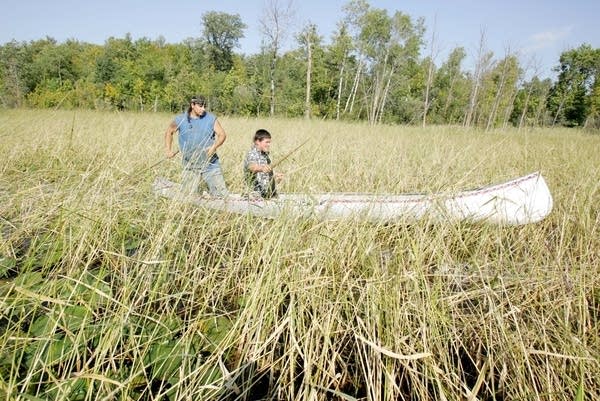In Minn., copper mining runs afoul of wild rice
Go Deeper.
Create an account or log in to save stories.
Like this?
Thanks for liking this story! We have added it to a list of your favorite stories.

Wild rice is sacred to the Ojibwe of Minnesota, but that may not be enough to protect it from the promise of jobs that a new copper-nickel mining industry would bring to the state.
Lawmakers and business interests are working to loosen Minnesota's water quality standards to make it easier to start copper mining in the northeastern part of the state, but it could come at an environmental price. The fight is being closely watched by the Fond du Lac Band of Lake Superior Chippewa, who fear that weaker standards could wipe out important natural stands of wild rice that provide food and medicine.
"It is sacred. It is a gift from the Creator. It is central to Ojibwe cultural identity. The cultural significance can't be overstated," said Nancy Schuldt, the band's water projects coordinator.
A key issue is whether the state's current limits on discharges of sulfates into water are outmoded. Minnesota's copper-nickel deposits are chemically tied up in minerals that also contain sulfur. When exposed to air and rain, these sulfide minerals form water-soluble sulfates. Competing interests have different ideas about what sulfate levels are safe for wild rice.
Turn Up Your Support
MPR News helps you turn down the noise and build shared understanding. Turn up your support for this public resource and keep trusted journalism accessible to all.
Wild rice is also a critical component of the region's ecosystem because waterfowl depend on it for food, said Paula Maccabee, a lawyer for WaterLegacy, which has asked a judge to dismiss a lawsuit by the Minnesota Chamber of Commerce that seeks to block enforcement of the state's sulfate standard. A ruling is pending.
The issue is coming to a head as Canada-based Polymet Mining Corp. seeks permits to tap one of the world's largest copper-nickel-precious metals deposits, near Hoyt Lakes on the eastern end of the Mesabi Iron Range. It says the project would create 360 permanent jobs and require about 1.25 million hours of construction labor. Other companies hope to follow.
LaTisha Gietzen, a Polymet vice president, said her company can meet the current standard and isn't lobbying for a change in the Legislature or financing the Chamber of Commerce lawsuit.
Environmental groups are concerned about water and air quality as well as wild rice. They say Polymet will set the pattern for other copper mining proposals and for future prospecting. Betsy Daub, policy director for Friends of the Boundary Waters Wilderness, said Minnesota has never seen large-scale mining of sulfide minerals, but the track record elsewhere has been disastrous, with long-term water pollution and costly government cleanups after mines go bankrupt.
Ojibwe legend says tribe members migrated westward and received a prophecy that they would know they had reached their home "when we saw the food that grows on the water," said Tom Howes, the band's natural resources manager.
Today, 300 to 400 Fond du Lac members are active ricers in any given year, Howe said, and they share their harvest with families and friends. While some have turned to mechanical methods to parch and hull the rice, he said it's still harvested by hand, with band members using sticks to knock the grains into their canoes.
Minnesota law limits sulfate discharges into wild rice waters to 10 milligrams per liter, a longtime standard that stems from research in the 1940s that found successful rice stands occurring in waters with that level of sulfates or less.
John Pastor, a University of Minnesota Duluth biologist and expert on wild rice, said that research remains sound.
Pastor said small-scale research at UMD seems to suggest that once sulfates get into the sediments at the bottoms of streams and lakes, microbes convert the sulfates back into sulfides. Sulfides seem to interfere with the development of the roots of wild rice plants, and the stunted roots starve the rest of the plants of nitrogen. That results in fewer and smaller seeds, and the leaves turn yellow, he said.
Mining supporters say it's time to re-evaluate the 10-milligram standard. They say the issue is important not just to copper-nickel mining but also to existing iron mining and industrial operations as well as municipal wastewater treatment plants.
Senate Minority Leader Tom Bakk, a Democrat who represents much of northeastern Minnesota, said more than 200 companies and 300 wastewater treatment plants across the state are operating under permits that don't mention the 10 milligram standard. When those permits come up for renewal, he said, they will be subject to standards that have been largely ignored and many operations will have trouble complying.
The Senate has passed Bakk's legislation suspending the standard and ordering the Minnesota Pollution Control Agency to set an interim number based on current research. The agency would also commission a $1.5 million study to determine what the final number should be. The House-passed version simply sets a 50-milligram standard pending the study. The differences await resolution in a conference committee.
Bakk said opponents of changing the standard just want to stop Polymet. He said nonferrous mining offers Minnesota a "big opportunity."
Howes, the Fond du Lac Band's resources manager, said he's skeptical of assurances from mining supporters.
"I don't trust them," Howes said. "I think they're just doing lip service. They know the tribes are in a position where they're speaking up and they want to sound like they're being good stewards."
(Copyright 2011 by The Associated Press. All Rights Reserved.)
Dear reader,
Political debates with family or friends can get heated. But what if there was a way to handle them better?
You can learn how to have civil political conversations with our new e-book!
Download our free e-book, Talking Sense: Have Hard Political Conversations, Better, and learn how to talk without the tension.




